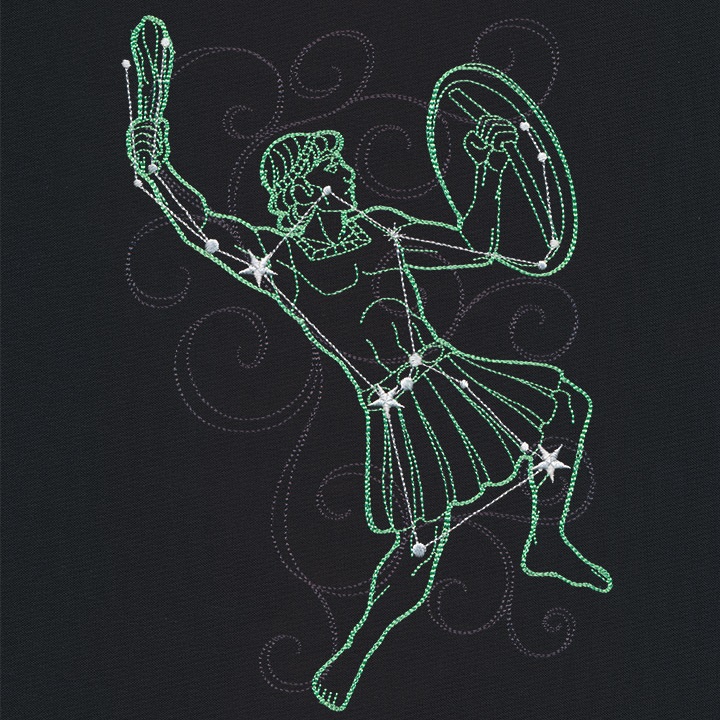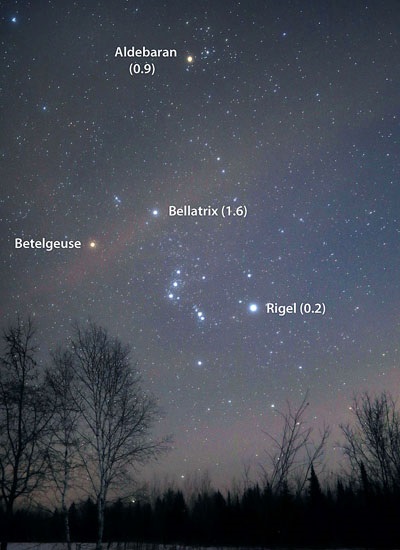
Orion, Image Courtesy Urban Thread
THE GREAT HUNTER
This New Year marks the fiftieth anniversary of me getting my first real telescope. Unfortunately it was later drowned in a flooded basement. Over the years, having done a lot of outreach, I have noticed that the two constellations that non-hobbyists are most likely to be identify in the sky are the Big Dipper (actually only a part of Ursa Major) and Orion. Of the two, Orion is actually much more striking, as it contains 7 out of the 68 brightest stars seen in the night sky.
In mythology, Orion was almost universally seen as a hunter or giant. To the Greeks, Orion was the son of Poseidon, god of the sea, and from his father, received the ability to walk on water, a useful talent for a great hunter. Orion had many adventures and misadventures, and according to one account, developed a relationship with Artemis, the goddess of hunting. Apollo, her twin brother, was jealous and resentful, as well as protective of his sister. He dared Artemis to demonstrate her hunting prowess by shooting a distant object barely visible in the sea. Her aim was true- the arrow hit the bullseye, not knowing it was actually the head of Orion, her lover, gone for a swim. In another of the many versions of Orion’s life and death, the hunter boasted that he would kill every animal on the planet. Gaia (Mother Earth) objected and sent a giant scorpion to kill Orion. To commemorate the event, Zeus placed both Orion and the scorpion in the sky, but as far apart as could be, to prevent further trouble. To this day, Orion is seen in the evening winter sky, while Scorpius is a fixture of the summer.
On a clear winter’s night, Orion is hard to miss in the sky, even if your location has a lot of city lights. During January, the hunter is lying on his side, rising in the east to southeast at nightfall, and standing straight up and down in the south near bed time. Four stars form a rectangle shape, surrounding the three stars in a row forming Orion’s famous belt. A much fainter sword dangles from the belt, while Orion also boasts a club and shield that are hard to see from light-polluted sites. Take a close look at the star in the middle of Orion’s sword- it may look fuzzy to the unaided eye, and definitely so in binoculars. This is actually the great Orion Nebula, a cloud of gas in which new stars are being formed, some 1,300 light years away from us.
Rigel is the brightest star in Orion, and eighth brightest in the entire night sky. It is one of the more distant stars visible to the naked eye at a distance of about 870 light years, so the light you see left it during the medieval era. Thus, it is some 70,000 times more luminous than the Sun. Rigel’s bluish white hue, signifying its hot temperature, can be seen in the picture below. As is true for most bright stars, the name Rigel is Arabic, and it can be translated as “the foot of the great one,” and figures in much science fiction media.
Perhaps even more famous than Rigel is Betelgeuse, at the opposite (northeastern) corner of Orion’s rectangle. One of the largest stars known, if placed at the center of our solar system, it would envelope Mercury, Venus, Earth, and Mars. It is normally almost equal in brightness to Rigel, but occasionally drops by almost half. Recently, however, it has been unusually dim. To check it out for yourself, compare Betelgeuse to other nearby stars using the picture below, used with permission of Sky & Telescope magazine.
Astronomers believe that Betelgeuse is a red supergiant star that is near the end of its approximately ten million year life cycle. It is common for such stars to be somewhat variable in brightness, and at the very end, they explode in a supernova. Scientists do not believe that Betelgeuse is at this point yet, and will most likely return to a more normal brightness over the next few weeks or month. If such a cataclysm did take place, we are at a safe distance of about 640 light years, and could witness Betelgeuse attaining the brightness of the crescent moon for a short time, and visible in broad daylight!

Use this photo, courtesy Sky & Telescope, to compare Betelgeuse to nearby stars of stable brightness. It shows a recent view of the east to southeast in the early evening. For example, if you think that it is between Aldebaran and Bellatrix in brightness but closer to Bellatrix, you might rate it at 1.3, as I did on New Year’s Eve. A star of magnitude 2.0 is 2.5 times dimmer than one of magnitude 1.0 and 6.25 times dimmer than one of magnitude 0.0. The Sun, Moon, some of the planets, and a couple of the brightest stars have negative magnitudes.
